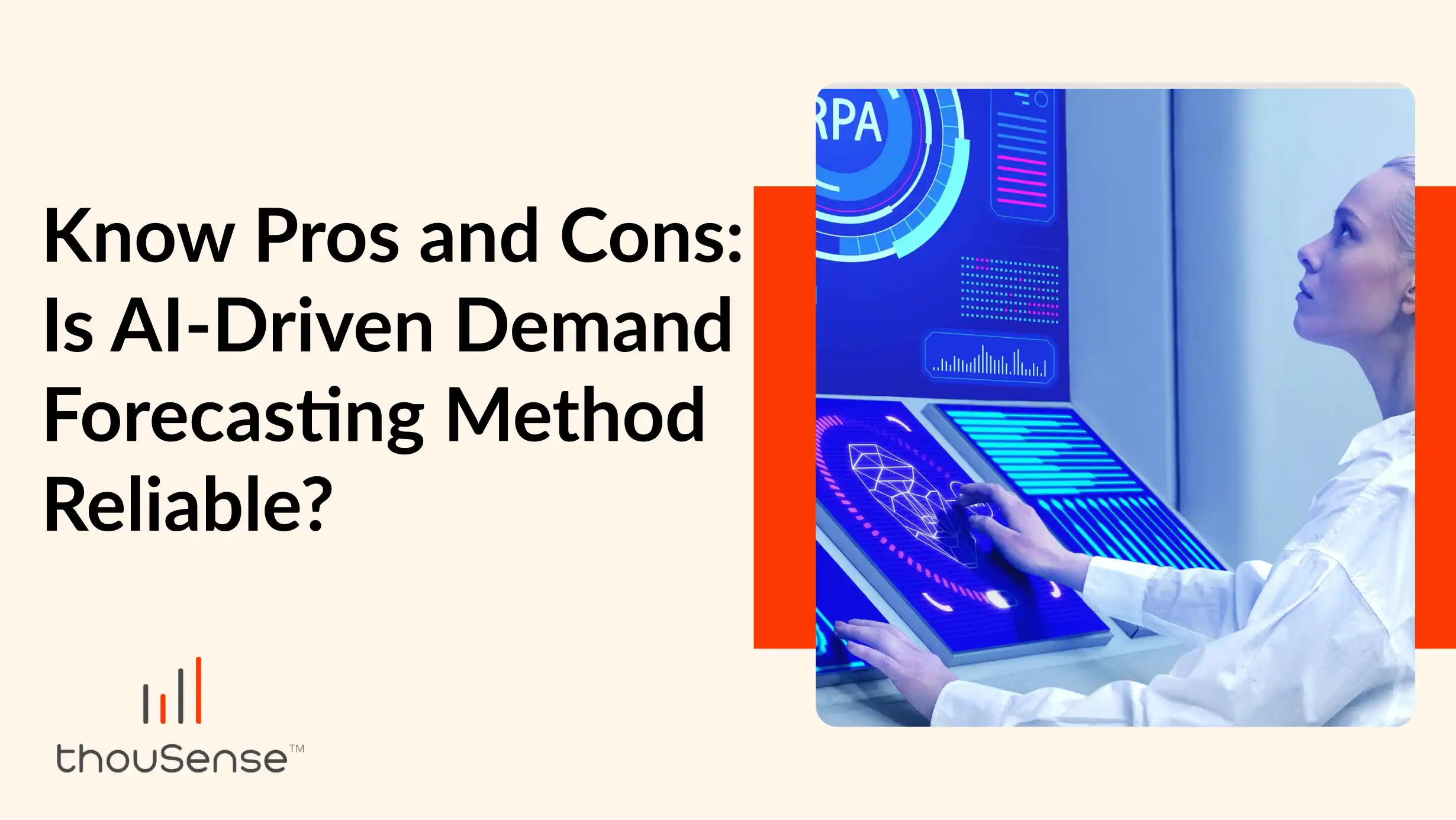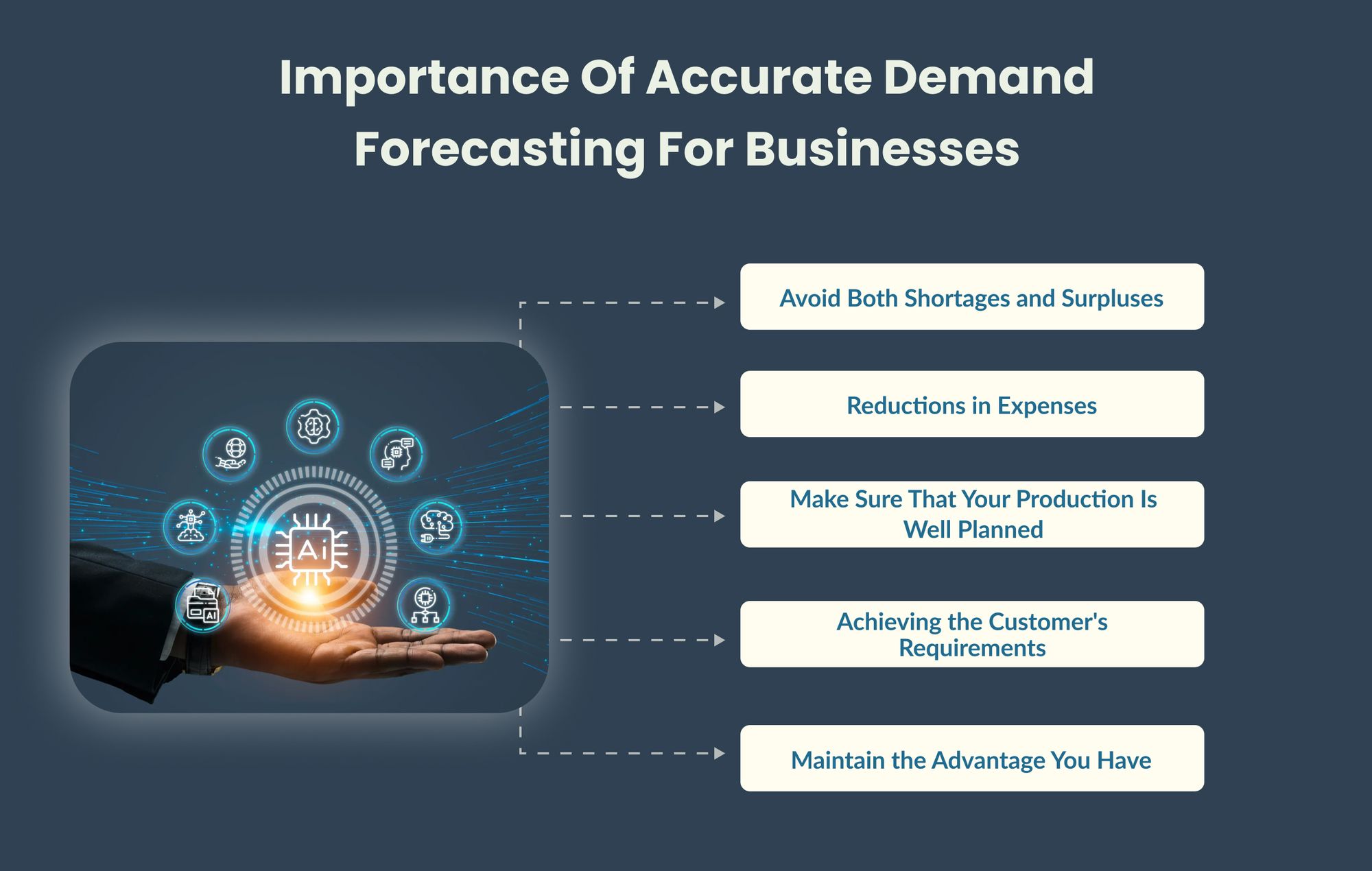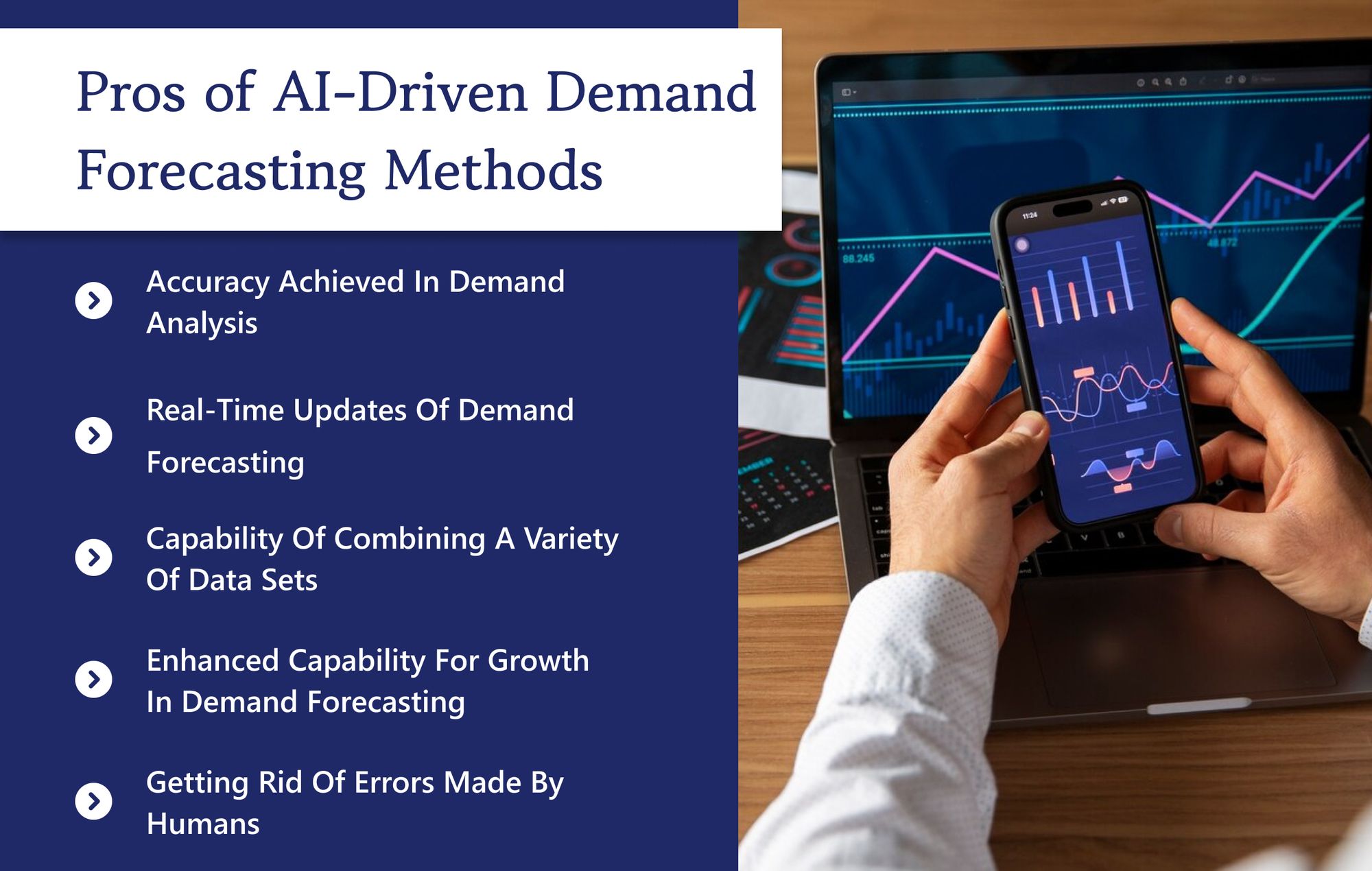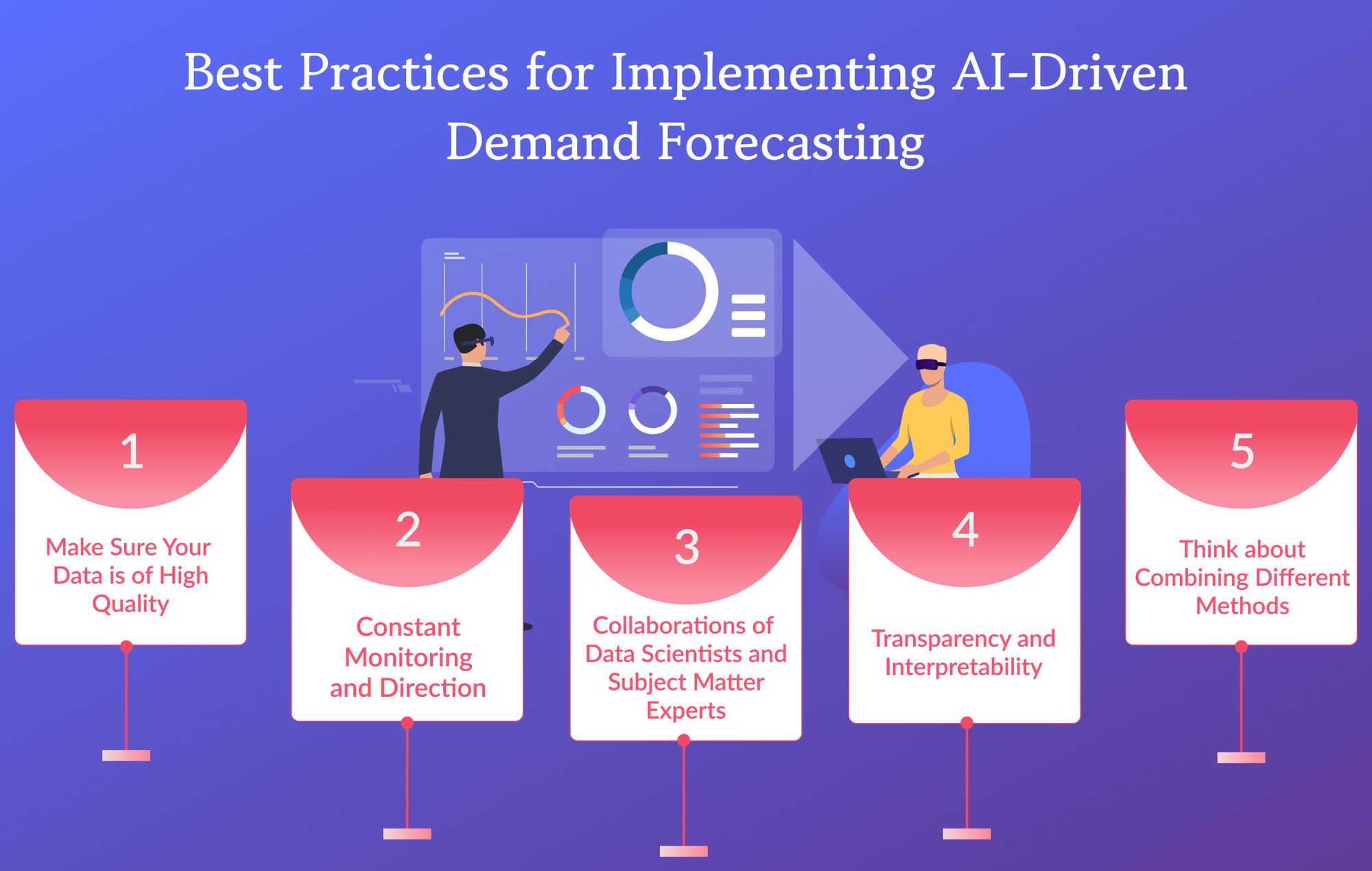Know Pros and Cons: Is AI-Driven Demand Forecasting Method Reliable?

What is Demand Forecasting?
Demand Forecasting is the process of estimating the preferences of customers in the future. Companies utilize this information to find out the quantity of their products that should be manufactured or stored.
To provide these projections, they analyze their past sales data, taking into consideration seasonality and ongoing trends. That is why it is like magic that helps to know what the buyers want!
Importance Of Accurate Demand Forecasting For Businesses
The ability to accurately forecast demand is extremely beneficial to businesses. It enables them to anticipate future trends in consumer purchasing. This has several important benefits:

1. Avoid Both Shortages and Surpluses:
The ability of a company to prevent both shortages and excess inventories can be achieved by careful monitoring of its production and stock levels. They never suffer a financial loss since their shelves are always stocked to capacity. It also safeguards them against losses resulting from the loss of sales or the waste of goods.
2. Reductions in Expenses:
Businesses can optimize their production and inventory planning when they have a better understanding of the demand from their customers. In this way, they are prevented from overproducing, which would result in a loss of money, or from missing out on sales due to a lack of inventory.
3. Make Sure That Your Production Is Well Planned:
When companies have a clear understanding of their consumer's needs, they can more efficiently manage their resources. This allows them to ensure that they are not wasting money on something that no one wants.
4. Achieving the Customer's Requirements:
Businesses can better satisfy the requirements of their consumers if they have a better grasp of what their customers want. This also helps them to stock their products accordingly.
5. Maintain the Advantage You Have:
Businesses can stay ahead of their competitors if they are using demand forecasting methods. By providing timely and relevant product offerings, they can both attract new customers and keep the ones they already have.
Introduction To AI-Driven Demand Forecasting
Demand forecasting powered by artificial intelligence uses advanced computer technology. It aids businesses in projecting future demand for their products or services.
Artificial intelligence (AI) powered systems leverage machine learning approaches that use complex algorithms to examine a variety of data. It examines data like historical patterns, current market conditions, and even social media activity. When using traditional approaches, one just looks at previous sales data.
Artificial intelligence's more accurate estimates can help businesses optimize their marketing, inventory, and manufacturing strategies. AI-driven demand forecasting allows businesses to anticipate their customers' requirements. It gives them a competitive edge by making well-informed decisions about the products and services they offer.
Imagine having a clever assistant around. thouSense is simply one of the prodigies.
Pros of AI-Driven Demand Forecasting Methods
Let’s find out some benefits of using AI-driven demand forecasting:

1. Accuracy achieved in demand analysis:
AI can test massive data sets and recognize intricate patterns. It improves the accuracy of forecasts. Hence, businesses can make decisions with the help of accurate information.
2. Real-Time Updates of Demand Forecasting:
AI is always learning from fresh data inputs in the market and adjusting its predictions. Businesses can make more flexible decisions when they have access to up-to-date estimates.
3. Capability of Combining a Variety of Data Sets:
AI-driven forecasting can incorporate data from a variety of sources. Tools for demand forecasting use data from previous and current market conditions. AI predictions can help firms gain a complete understanding of demand patterns. They take into account many factors that reflect the complexities of the market.
4. Enhanced Capability for Growth in Demand Forecasting:
AI-equipped systems are highly scalable. They can handle growing amounts of data and the demands of businesses. AI-driven demand forecasting methods never sacrifice precision or efficiency. Thus, businesses have the opportunity to extend their forecasting skills. At the same time, they can get reliable and trustworthy predictive insights.
5. Getting Rid of Errors Made by Humans:
The focus that AI places on data-driven algorithms results in more dependable forecasts. This is because these algorithms reduce the impact of human biases on the procedures. When predictions are less skewed, they are more trustworthy. It leads to improvements in strategic planning and gives better forecasts.
Cons of AI-Driven Demand Forecasting Methods
There are various factors affecting demand forecasting. Let’s see some challenges to AI-driven demand forecasting:
1. Dependency on Data Quality:
Artificial intelligence forecasting demands high-quality data. If the supplied data is unreliable, biased, or erroneous, then there will be forecasts that may be off.
2. Initial expenditures and Implementation expenses:
There is a possibility that the deployment of a forecasting system driven by AI will be costly. Businesses must pay for the heavy costs of the systems and software, and the training of workers.
Best Practices for Implementing AI-Driven Demand Forecasting
Here are some of the best practices required for implementing AI-driven demand forecasting:

1. Make Sure Your Data is of High Quality:
It is necessary to verify that the datasets are accurate, and clean, before training AI models. Accurate dependable data is a prerequisite for AI-driven forecasting.
2. Constant Monitoring and Direction:
Aside from leveraging user feedback to improve AI models, it is critical to monitor forecast accuracy and performance indicators. Continuous examination throughout time leads to iterative changes. These changes have the potential to boost the accuracy of forecasts.
3. Collaborations of Data Scientists and Subject Matter Experts:
Domain experts and data scientists make it easier to use industry-specific information. They make sure that AI models are in line with business goals. They take into account the complexities of the business world.
4. Transparency and Interpretability:
The creation of AI models for prediction needs to be one of the key goals. Businesses involved can gain a better grasp of the forecasting process. We can achieve this by using models that are transparent and easy to understand.
5. Think about Combining Different Methods:
Discover more about the advantages of combining conventional approaches with AI-driven forecasting. The hybrid systems will help to improve forecast accuracy. One outstanding choice is thouSense, which is well-known for its precise demand projections.
thouSense provides advanced AI capabilities that enable accurate demand forecasting. It is scalable, adaptable, and interfaces with a variety of software and data sources.
Conclusion
AI-driven forecasting is a useful tool for helping firms estimate future demand. However, putting it into effect comes with several difficulties and risks. There are quite many possibilities of making mistakes or incurring significant initial costs. Nevertheless, it can be successful if a few essential steps are carried out. Businesses can achieve their goals of employing AI-driven forecasting to its best potential.
Additionally, remaining current with the ever-changing corporate world is crucial for adapting AI-driven forecasting strategies. Companies can accomplish this by placing a high priority on the utilization of high-quality data. They can also combine different tactics and engage in conversation with industry experts.
FAQs
1. How can businesses overcome the challenges of AI-driven demand forecasting?
Ans: Businesses should focus on ensuring high-quality data inputs. They should regularly update and retrain AI models and validate AI-generated forecasts. One can overcome the challenges easily with domain expertise and market insights.
2. Can we integrate AI-driven demand forecasting methods with existing business processes?
Ans: Yes, we can integrate AI-driven demand forecasting methods with existing business processes. It will enhance decision-making, optimize resource allocation, and improve overall operational efficiency.
3. How reliable is AI-driven demand forecasting compared to traditional methods?
Ans: AI-driven demand forecasting is generally more reliable. This is due to its ability to analyze complex data sets, provide real-time updates, and reduce human biases. However, the reliability is directly dependent on the quality of the data used for analysis.